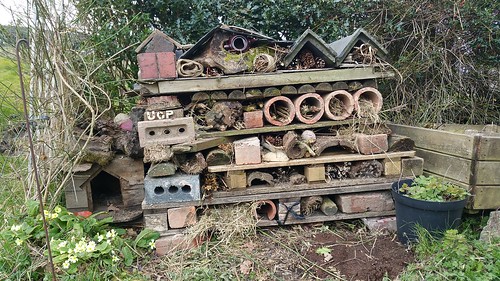Living in the countryside as we do, wildlife is never far away. We have many species of birds visiting the garden each day, including a tawny owl often heard but rarely seen; we have several bird boxes on our land. There are voles and mice, which our cats regularly bring in as gifts! There are moles, probably rats too although we have not seen any. Some squirrels dare to climb the bird feeders to steal the peanuts and I have seen evidence of hedgehogs but not actually seen any yet. We have slugs, woodlice and spiders too. We share our piece of land with them, all part of the ecosystem.
As our flower and vegetable seedlings are growing well and some will soon be going outside, it has made us think about protecting them from what could be considered as pests, eating young, tender plants before they make it to harvest. What can we do about slugs, aphids and other insects that could decimate our plants? Of course, there are some chemical products available on the market to get rid of them but this harsh method does not fit well within our philosophy of gardening with a light footprint on the environment. Not only is the efficacy of these products rather dubious, but they also harm a lot more than the intended target. The serious decline in bees particularly but also butterflies, birds and some animals, caused by the use of poisonous neonicoticoids as insecticides is an example of the extensive damage and soil, water and air contamination caused by the use of them.
Whilst we want to be successful in growing good crops of fruit and vegetables to provide food for ourselves, we are keen to do so while respecting the environment, which includes animals and insects that live in our garden. It can be a tricky balance to achieve, especially as we watch the mole hills getting ever closer to the vegetable beds! Yet we know that, overall, this balance is best achieved with biodiversity and that attracting and encouraging beneficial insects and animals into our garden is ecologically sound.
One of the things I did recently, in the spirit of providing habitat for wildlife in our garden, is to build a bug hotel. The recommended location is near some shade so I chose a piece of flat-ish ground near a hedge, under a holly tree and close the pond. I used pallets, bricks, tiles and slate for the structure, all found around the smallholding. In recent months, we have demolished walls that were beyond repair and so have accumulated a fair amount of bricks, blocks and general rubble that I was able to put to good use in the building of this mansion for insects. We were going to take the rubble away to the local tip but really where does all this end up after that? There is no "away"!! I used broken pots (did you see the teapot in the roof??), piles of dead wood, twigs, hollow stems, straw, hay, sheep's wool, dead leaves, pine cones and bark to fill in the gaps. A very creative, fun and satisfying project!
Now we await the arrival of the various insects and small animals. We hope our newly constructed bug hotel will be a cool shelter for frogs (they eat slugs!) and a good habitat for ladybirds (they eat aphids!). There is a space for a hedgehog to hibernate in next Autumn. And we hope all these nooks and crannies will accommodate a wide variety of insects. The more the merrier: in sustainable gardening, the more diversity we can have, the less chance there is for one species to overpopulate and take over (and then become a pest). The same applies to plant and soil diversity so I will now give some thoughts to what to plant and where in order to maintain a dynamic, healthy and harmonious ecosystem in our garden.

An interesting and thoughtful post. The bug hotel looks great and I'm sure that the first residents will arrive in no time. Please share some photos when the guests arrive. Liz x
Posted on By Liz
Thanks, Liz. I put some sunflower hearts in the little teapot and it hasn't taken birds long to find them! They were busy back and forth there today :)
Posted on By Maryline
We too now have Mrs blue tit building her nest in our new nesting house - she appreciates that the pussy cats have departed for pastures new in Wales.
Posted on By Sheila
Indeed, Sheila, your Mrs Blue Tit can safely build her nest. No Lola or Oscar to disturb her!!
Posted on By Maryline